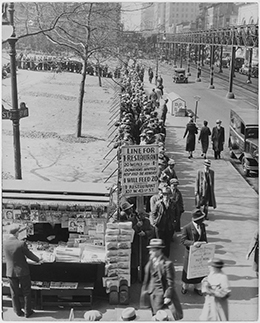| << Chapter < Page | Chapter >> Page > |
The new hardships that people faced were not always immediately apparent; many communities felt the changes but could not necessarily look out their windows and see anything different. Men who lost their jobs didn’t stand on street corners begging; they disappeared. They might be found keeping warm by a trashcan bonfire or picking through garbage at dawn, but mostly, they stayed out of public view. As the effects of the crash continued, however, the results became more evident. Those living in cities grew accustomed to seeing long breadlines of unemployed men waiting for a meal ( [link] ). Companies fired workers and tore down employee housing to avoid paying property taxes. The landscape of the country had changed.

The hardships of the Great Depression threw family life into disarray. Both marriage and birth rates declined in the decade after the crash. The most vulnerable members of society—children, women, minorities, and the working class—struggled the most. Parents often sent children out to beg for food at restaurants and stores to save themselves from the disgrace of begging. Many children dropped out of school, and even fewer went to college. Childhood, as it had existed in the prosperous twenties, was over. And yet, for many children living in rural areas where the affluence of the previous decade was not fully developed, the Depression was not viewed as a great challenge. School continued. Play was simple and enjoyed. Families adapted by growing more in gardens, canning, and preserving, wasting little food if any. Home-sewn clothing became the norm as the decade progressed, as did creative methods of shoe repair with cardboard soles. Yet, one always knew of stories of the “other” families who suffered more, including those living in cardboard boxes or caves. By one estimate, as many as 200,000 children moved about the country as vagrants due to familial disintegration.
Women’s lives, too, were profoundly affected. Some wives and mothers sought employment to make ends meet, an undertaking that was often met with strong resistance from husbands and potential employers. Many men derided and criticized women who worked, feeling that jobs should go to unemployed men. Some campaigned to keep companies from hiring married women, and an increasing number of school districts expanded the long-held practice of banning the hiring of married female teachers. Despite the pushback, women entered the workforce in increasing numbers, from ten million at the start of the Depression to nearly thirteen million by the end of the 1930s. This increase took place in spite of the twenty-six states that passed a variety of laws to prohibit the employment of married women. Several women found employment in the emerging pink collar occupations, viewed as traditional women’s work, including jobs as telephone operators, social workers, and secretaries. Others took jobs as maids and housecleaners, working for those fortunate few who had maintained their wealth.

Notification Switch
Would you like to follow the 'U.s. history' conversation and receive update notifications?